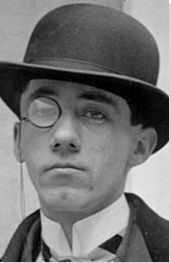Summary of Gino Severini
Severini was one of the most progressive of all the twentieth-century Italian artists. An early and important figure within the Futurist movement, the Paris-based Severini produced unique works that, through their emphasis on urban Parisian scenes (rather than machines), broadened the thematic possibilities for the movement. Having exhausted his commitment to Futurism, and to the French avant-gardes' penchant for pictorial deconstruction, he shifted his interest to Neo-Classicism; a move that saw him aligned with the interwar "Return to Order" movement. His modernist credentials were tested somewhat through his associations with the Fascist leader Benito Mussolini's "Third Rome" project (the dream of establishing a New Roman Empire), for which he provided murals and mosaics for architectural structures inspired by imperial Rome. In later years, however, Severini was "reborn" through his new commitment to the Catholic faith which saw the artist produce religious mosaics so finely skilled they earned him the title: "Father of Modern Mosaics". Complementing his considerable achievements as a painter and mosaicist, Severini proved an accomplished polemicist, publishing theoretical essays and books on the art of painting throughout his long career.
Accomplishments
- Severini's Futurists works were distinguished in the way they privileged the lyrical and rhythmical joys of urban life. Allowing for the influences of Divisionism, Fauvism, and Cubism to inform his work, Severini used contrasts in color and shape with the primary goal of heightening the decorative and kinetic quality of his work. In this way he facilitated a truly cross-cultural Futurism to emerge.
- Leaving behind the Parisian nightclub scene (to which he had become so attached), and disillusioned with the violent and chaotic path trodden by the Italian Futurists, a more reflective Severini turned to his friend Pablo Picasso and the lessons of Synthetic Cubism. By adopting its flattened planes and simplified forms, Severini produced a series of still lifes and landscapes that found beauty in everyday and/or natural subjects.
- Putting to one side any sense of patriotic duty (the Futurist remained steadfast in their goal of maintaining a uniquely Italian culture), and the experimental tendencies of the French avant-garde, Severini joined a pan-European group of artists and intellectuals in his support for the interwar "Return to Order" movement. His Neo-Classical style saw him bring the principles of the Italian Renaissance to modern subjects. Such was his enthusiasm for the Classical movement, and particularly its legacy of pictorial proportion and balance, he published (much to the chagrin of the Cubists) an influential theoretical tome, Du cubism au classicisme (From Cubism to Classicism) in 1921.
- Back in his native Italy, Severini's later career saw him bring renewed interest and credibility to the ancient art of Byzantine mosaics. Having contributed retro-imperial walkways for Mussolini's bloated architectural edifices, he worked under the influence of a new spiritualism (one brough on by personal tragedy) that saw him visualize Christian parables for churches in Italy, Germany, and Switzerland.
The Life of Gino Severini
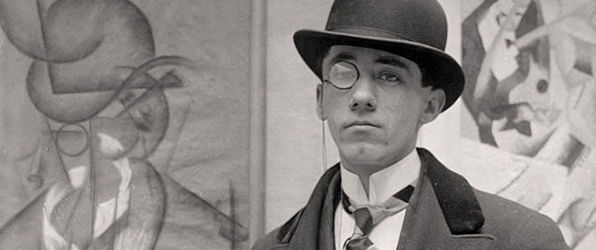
Severini's declared that one could locate the dynamism of modern life, not so much in the driving pistons of machines, but more in the "beautifully masked and under-dressed women", the "showers of confetti" and the "multicolored streamers" he encountered in the nightclubs of Paris.
Important Art by Gino Severini
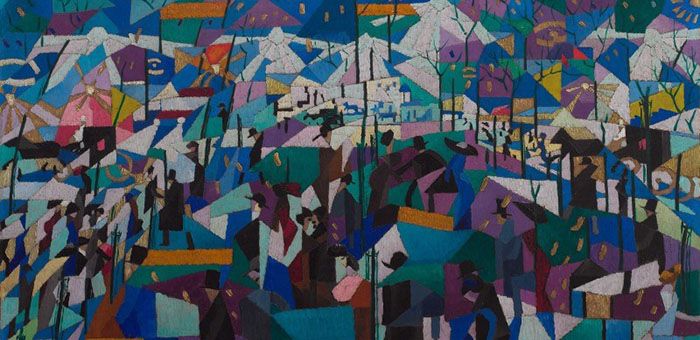
Le Boulevard
Severini was one of the most important figures within the first flowerings of the Futurist movement. Based in Paris (rather than Milan or Rome) he is credited (amongst other things) with widening the scope and appeal of Futurism by focusing on contemporary urban life rather than the dynamic workings of machines. Like other modern movements, the Futurists wanted to show the modern world, not as it was seen (literally), but rather as it was experienced. One of the ways in which Severini sought to achieve this was through rhythmical and repetitive shapes that recreated a kind of lyrical or musical effect. In this respect, Le Boulevard is one of Severini's best-known early works. Thematically, it deals with the march of modernity with the crowded canvas showing pedestrians moving up and down one of the city's busy boulevards. Trees grow upwards on the canvas and we can also discern small animal figures. The "old world" is represented here through a horse and cart (to the right of the frame) which is juxtaposed by the dazzling headlights of a motorcar (on the left).
The art historian Celia White summed up the work by saying "in the tumultuous [...] overlapping visual planes [that] rise to the surface [Severini presents] a scene at once solid and dispersed, defined yet indecipherable". Movement and change are represented thus through the triangulated forms and repeated patterns, creating a patchwork-like effect. The influence of Divisionism is evident here, with the complementary colors that accentuate contrast and bring a musical quality to the work, and the color palette can be attributed to the influence of Fauvism that had recently defined the Parisian avant-garde. As art critic Michael Glover remarked: "Movement - and it is a canvas which seethes with movement - is represented by the juxtaposition of brilliant, triangular prisms of colour. Certain physical details - the men in their bowler hats, for example - are very clearly represented". It is known that Severini showed the work to Georges Braque, with whom he shared a studio complex in Montmartre. Indeed, Severini would channel the principles of Analytic and Synthetic Cubism in subsequent works.
Oil on canvas - The Esoterick Collection of Modern Italian Art, London
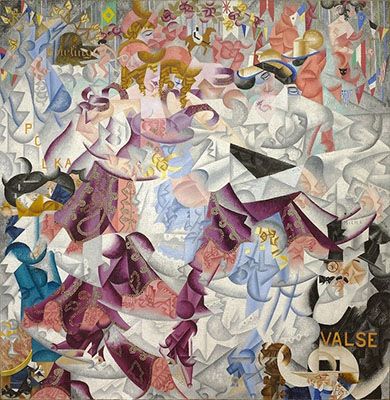
Dynamic Hieroglyphic of the Bal Tabarin
Futurists were well known for their fascination with kinetics - especially in movement of cars, trains and planes. But Severini stood apart from this tradition in his preference for studies of the human form. Inspired by his hedonistic nights in Parisian clubs, the Dynamic Hieroglyphic of the Bal Tabarin depicts the movement and noise of the dancehalls which Severini loved to frequent. (He wrote in his autobiography: "They were expensive, but being a good dancer, I was soon admitted free and received special favors".)
In its fragmented planes, the work clearly carries the influence of Cubism. The subject at the work's heart are dancing women; one with curled brown hair, bare-shouldered, whose pink, blue and purple dress contrasts with her partner who wears white. Alongside her dances a hatted and mistouched suitor whose moves are intimated through repeated shapes laid out in a spiral. All around are cultural references: the words "polka" (bohemian dance) and "valse" (waltz) share the frame with a bunting of national flags. The frame is dense with figures and shapes thus emphasizing the rhythmic atmosphere of the nightclub.
Severini wanted to create a multi-sensory experience, which he embellished with sequins around the canvas. But he merges these Cubist elements with the Futurist interest in capturing the dynamism of motion. His philosophy was that his Italian counterparts must visit Paris to learn about the cutting-edge developments in modern art. According to art historians Dr Charles Cramer and Dr Kim Grant: "In Dynamic Hieroglyphic he adopts [Braque and Picasso's] recent innovations by including painted words and collaging sequins onto the painting's surface. Severini's painting is, however, markedly different from their Synthetic Cubism in its subject matter as well as its brilliant colors and decorative qualities. In this respect it is closer to the paintings of the Salon Cubists, such as Jean Metzinger's Dancer in a Café". Severini described the work as one of his best canvases.
Oil on canvas with sequins - The Museum of Modern Art, New York
Dancer = Propeller = Sea
This colorful abstract work represents the movement of a dancer, a propeller, and the sea. The curvilinear shapes can be understood at once to depict motion and the physicality of the ocean, while the sharper, straight edges supply the manmade element. The bright spectrum of color, interspersed evenly throughout the canvas introduce a note of dynamism and vitality. The Futurists were fascinated by the interactions of movement and matter and the dynamic speeds of the modern world, and this work aims to capture the sensory and visual analogies that resonate across seemingly unrelated objects.
Curator Lisa Messenger said of this piece: "In Severini's mind there was a visual equivalent between the movement of a dancer, an airplane propeller spinning and the roiling motions in the sea. He has combined them into one big abstract composition that suggests simultaneity. You can see them all at the same time, the same way Cubism tried to show the many sides of the same head". Severini was a signatory of the Futurist Painting Technical Manifesto (with Balla, Boccioni, Carrà and Russolo) which stated: "The gesture which we would reproduce on canvas shall no longer be a fixed moment in universal dynamism. It shall simply be the dynamic sensation itself [...] On account of the persistency of an image upon the retina, moving objects constantly multiply themselves; their form changes like rapid vibrations, in their mad career".
Interestingly, Severini used a diamond shaped canvas to enhance the sense of motion in this work - a move that would have been highly unusual at the time. However, this novelty was lost on the work's caretakers and when it was exhibited in Alfred Stieglitz's New York gallery in 1917, it was hung as a regular square canvas. It was also mis-hung when it went to the Metropolitan Museum of Art. It was not until Severini saw for himself how his painting had been (mis)hung that it was repositioned according to the artist's wishes.
Oil on canvas - The Met, New York
Maternity
While the Futurist remained committed to presenting a uniquely Italian culture between the two World Wars, many intellectuals of the age (artists, architects, designers, graphic artists and so forth) supported an ambitious ideological project that promoted a so-called "Return to Order". The art historian Rose London summed up the ethos thus: "Historically, in times such as these, wherein society is craving order, simplicity, and security, art often desires the same; and we bear witness to a 'call to order' - a return to classical tradition". She added that this pattern was most "vehemently [...] seen during and after the First World War, with Picasso's neoclassical turn, Gino Severini's 1916 series of figurative paintings exemplary in 'Maternity', and Juan Gris's mid-war return to figure subjects and old master paintings".
While Severini was still experimenting with Cubist techniques, Maternity was the first of his works to signal his shift towards Neo-Classicism; evident here in his modern treatment of the classical elements of motherhood. Severini's "mother" is patently not lionized or beautified but her pose still adheres to the rules of a classical proportion. Her clothing is modern but the folds in the fabric of her blouse is reminiscent of classical sculpture and painting. Her hairstyle appears rather classic in design, but her facial expression and body language connote a sense of modern anxiety. The mother is posed, but there is (as one had come to expect from Severini) a sense of movement in the painting: she seems uncomfortable sat on her wooded stool while her demeanour and facial expressions - her eyes are almost closed and her face is expressionless - suggest she is very much representative of a mother of her time; a mother who worries about the fate of her children in the midst of the "war to end all wars".
Oil on canvas - Museo dell'Accademia Etrusca
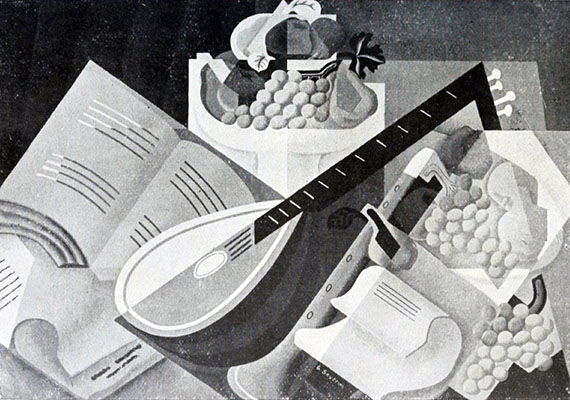
Nature Morte (Still life)
This work was one of a series of still lifes Severini produced before the 1920s. The Synthetic-Cubist influence is clear, in the combined flattened planes, the simplified forms and the straight edges that extend beyond the subjects. The canvas represents a more settled time in the artist's life - while his earlier works showed dancers, nights out, and Parisian energy, here is absorbed in the calm of the quotidian that was a ripple effect of his time of quiet refuge in the French countryside during the German invasion. It also represents his close connection with his French friends. The Futurists could be a rowdy bunch and there was often a note of hostility between the French and Italians. Severini wrote in his autobiography: "I always deeply regretted the erroneous Futurist feeling of antagonism, of competing with Paris and Cubism; it would have been more advantageous for them to function harmoniously". Severini was a socialite who brought opposing factions together, and this work pays tribute to the family bonds he found Paris, a city he regarded as his intellectual and spiritual home.
The influence of Picasso in this work is clear; in subject matter as much as style. The pair shared a close friendship, often eating out together when Severini was living in Paris. He said: "Picasso lived a rather conventional life with his ladyfriend [Eva Goeul] as if they were a married couple, and therefore all around him were still-life objects, home-like objects, which caught his eye a hundred times a day. Perhaps that was, if not the determining factor in his frequent choice of the still-life, at least the explanation for it. After my marriage when I began to lead a more sedentary life, I too, understood the beauty inherent in certain trivial objects, and the idea that a painting or a poem might be composed around anything at all became quite clear to me".
The art historian Celia White wrote that the "death of Boccioni in 1916 brought Severini closer to the cubist and purist painters, as well as Henri Matisse and Jean Cocteau". She added that a "greater exposure to the bold colour and structured surfaces of synthetic cubism and the purist work of Fernand Léger and Amédée Ozenfant initiated a shift in Severini's practice away from the expression of movement in favour of an emphasis on plasticity". The upshot was that by "the time of Nature morte, the objects are invested with a far less abstract solidity that presages Severini's return to classicism in the early 1920s".
L'équilibriste
Underneath a trespassing blood-red sky, and placed within the grounds of classical architectural ruins, circus performers and deformed jesters practice their craft with a cold detachment. Indeed, the performers complement the freestanding colonnades and porticoes that signify the demise of the great Roman age. The painting carries a palpable feel of mourning, and a longing for a return to a time when civilization and progress were to be celebrated rather than dreaded. As White put it, "Painted between the two world wars, L'Équilibriste's geographical and historical uncertainty speak of a Europe in limbo - reeling from the effects of one war while anticipating the next".
Severini's "return to classicism" reached its apotheosis with L'équilibriste, a painting produced when the threat of another war and the march of fascism was haunting the minds of many artists. The "Return to Order" movement offered a way of restoring some sort of formal equilibrium to painting, but in terms of Severini's own oeuvre, L'équilibriste ranks as a keywork in his stylistic journey. Indeed, White puts Severini's move from the avant-garde (Nature morte) to Neo-Classicism (L'équilibriste) down to "an aesthetic [that] may be attributable to the lasting effects of his formal art training in Rome and an exposure to the divisionist technique at an early age" - what she called Severini's newly found devotion "to reconstructing the surface of the painting following decades of deconstruction" - just as much any earnest political gesture. White's argument was that Severini's reputation has suffered unjustly because of his "duel" (Italian/French) identity. But, she argues, the classicism of L'équilibriste, "combined with [the] influence of his Italian roots, allowed Severini to come full circle by the 1930s, back to what he had always excelled at: the production of a harmonious, ordered canvas. This love of order, the aspiration towards solution rather than dissolution, permeates all of his work, and as such [he deserved to] be celebrated rather than sidelined" in the history or early twentieth century modernism.
Banca Monte dei Paschi di Siena collection
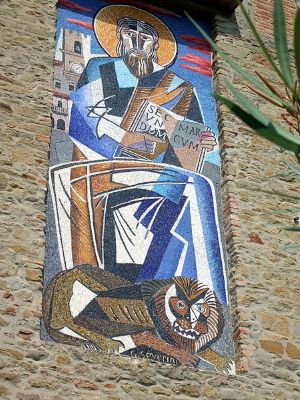
Mosaic of San Marco
In later life, Severini sought a spiritual calm in his work which he realized chiefly through frescoes and mosaics. These commissioned works brought him financial stability but, more than that, they bestowed on him a sense of order that brought him closer to God and earned him the title "Father of Modern Mosaic". In Mosaic of San Marco, he produced a Cubist-inspired portrait of St Mark the Evangelist with the lion at his feet for the facade of the church in the town of his birth.
Inspired by Early Byzantine mosaics, Severini claimed that working in this medium gave "him time to think, to gather, and see what might be the best way to express his desire". He likened this process to the way Cezanne placed his brush strokes one by one on the canvas. As art historian Ilona Jesnick observed: "It was an extraordinary journey for an artist as pivotal to Modernism as Severini: the urbane Italian of Parisian café society, the Futurist, the atheist. He became the advocate of the serene skills of artists expressing their spiritual world of Christian faith. Severini was a man of contradictions".
Although he had previously declared himself an atheist (he had been a Futurist after all), the shock of the loss of his son Tonio helped bring him back to Catholicism and its religious narratives. Severini said he felt "strongly bound to Cortona", so it was most fitting that his mosaic should be displayed on the main church in the town in which he was both born and buried. As Jesnick said: "Decoration, with its ancient heritage and social function, had become, for Severini, a truer art than the self-regarding work of the easel painter". He also believed that the mosaic must respect the architecture of the building, renouncing the use of foreshortenings and perspective. This made Cubism the most suitable style as it emphasized the surface. Severini said: "I have [...] so much love for this wonderful art form [...] Mosaic can powerfully help restore to art the order, clarity and purity and also the sense of reality that the modern world with its many contradictions can no longer give".
Mosaic on the front-facade of the Church of St. Mark - Cortona, Italy
Biography of Gino Severini
Childhood
Gino Severini was born in the town of Cortona, a province of Arezzo, Tuscany. His mother earned a living as a dressmaker while his father worked as a steward at the Magistrate's District Court, a position the painter later described as "the lowest rung in the whole civil service system". His early years were scarred with tragedy when his younger sister died of malaria. Writing in his 1946 autobiography The Life of a Painter, Severini recalled: "Her death was the first real sorry event of my life, stamping it indelibly, and causing me to suddenly grow up". When he was 15, his parents moved away, leaving their son in the charge of his paternal grandparents with whom he lived in "utterly miserable conditions". He did however gain early life skills by assisting his laborer grandfather in his job as a bricklayer. Severini later stated (with some satisfaction) that: "The inhabitants of Cortona are notoriously rugged, fiercely proud, and independent [and] I feel in myself shades of that same toughness and independent spirit and a bit of that vital juice, that sap, running through my veins".
At the age of 15 Severini was expelled from the entire Italian school system after stealing an exam paper. Along with five classmates, he snuck into school through a window and unlocked the principal's office with a homemade key. The teenagers were sent to the court in Arezzo, and then the Court of Appeals in Florence. The boys escaped a custodial sentence but Severini never again attended formal education. While he had not yet shown any kind of aptitude for drawing, he loved acting in plays, designing sets on sheets of newspaper, and taking on directing roles in amateur productions which he set up with his friends.
Early Training
Following his expulsion from the school system, Severini rejoined his father whom he helped with his work, much of which involved traveling the length and breadth of Italy serving legal papers. The family moved to Radicofani, in the Province of Siena, where Severini began to paint, studying reproductions of Titian, or copying from postcards and magazines. The young Severini began to think about becoming a professional artist, though he had little access to materials and worked from a set of watercolors mixed with rubber cement to give the impression of oil. He commented: "I took my subjects from the widest range of reproductions [...] Rarely did I copy anything from nature. It never occurred to me that painting was work; it was all just a game to me".
His mother, realizing that his opportunities were limited in rural Italy, took her son off to Rome where she worked as a seamstress while Severini undertook work as a shipping clerk. His mother subsequently returned to her husband, and Severini was left in Rome to fend for himself. He wrote: "I lived in hapless conditions. I had rented the corner nook of a kitchen in via Sardegna as sleeping quarters, where a couch and a table just fit next to the window". With the support of a patron from Cortona, Severini was able to attend art classes at the Free School for Nude Studies (an annex of the Rome Fine Art Institute) and at the arts academy Villa Medici, where he began reading philosophy and politics. His formal art education ended after two years however when his benefactor, on seeing Severini's somewhat unruly portfolio, withdrew his financial support, telling his young charge, "I absolutely do not understand your lack of order".
In 1900 Severini was introduced to the influential Italian painter Umberto Boccioni at a musical performance. "We took to each other instantly", he said, "We apparently shared many of the same opinions". The next day they went together to paint the Nomentana Bridge and to swim in the Aniene River and thus began a lifelong friendship that gave rise to a "healthy rivalry" between the two men. Severini was soon welcomed into Boccioni's artistic circle and through them he was introduced to the writings of Arthur Schopenhauer, Friedrich Nietzsche, Pierre-Joseph Proudhon, the Russian novelists, and to the general principles of Marxism.
It was Boccioni who introduced Severini to Giacomo Balla who, in turn, schooled him to the technique of Divisionism; the process of painting with divided, (rather than mixed) color and breaking the painted surface down into a series of stippled dots and stripes. In 1903 and 1904, a few of Severini's works (thought to be rural landscapes presented in a naturalistic style) were accepted into the annual Amatori e Cultori exhibition. Flushed we a new self-confidence, he moved to Florence where, aside from a few commissions to copy works for the Uffizi Gallery, he failed to prosper. Having returned briefly to Rome, where he contributed some portraits for covers of the edition of the Socialist newspaper Avanti, he headed for Paris, arriving in the French capital in the November 1906. He would say later, "The cities to which I feel most strongly bound are Cortona and Paris: I was born physically in the first, intellectually and spiritually in the second".
Mature Period
"Few have ever arrived in an unfamiliar city as penniless and helpless as I was", the artist wrote about his arrival in the French capital, "I had no friends, no money (barring the 50 francs I counted in my pocket that evening), only a scant knowledge of French, and most important of all, I had no profession; I was a nonentity". His fortunes took an upturn two months later when he bumped into his fellow countryman Amedeo Modigliani outside the Moulin de la Galette. The two men would become lifelong friends. He soon befriended Suzanne Valadon and Paul Signac and through that association he became a fixture of the Parisian avant-garde scene, socializing with artists of the calibre of Georges Braque, Juan Gris, Pablo Picasso, and individuals from literary and theatrical circles such as Max Jacob, Guillaume Apollinaire, Jules Romains and Lugné-Poë. Based in the bohemian district of Montmartre, Severini dedicated himself to his painting. According to the art historian Celia White, Severini's "canvases during this decade [fused] the harmonious composition of the traditional landscape painting with the dissolving surfaces and complex manipulation of colour that had emerged in art following Impressionism". But, as the art historian Ester Coen, observed, Severini had by now become "fully aware of the importance of Balla's teaching and of the need to break away completely from an excessively naturalistic approach" to his painting.
Severini lived, in his words, in a "cold sixth-floor Parisian room without proper bedding, enough food or heat"; a situation he described as "absolutely murderous". He was also unfulfilled in his art and destroyed most of his efforts. He made friends, however, with the Italian painters Bucci, Colao, Duderville, and the writer Buggelli, all of whom lived near Severini in a small hotel room near Montmartre. They would invite him round for a feast of spaghetti and other delicious foods and he recalled that: "Either dreamers or realists, these four friends, together with Baldo and Modigliani, kept my memories of Italy alive".
Severini took naturally to the Parisian social scene, and would hold cramped parties in his tiny room, where people would dance old Italian regional polkas and mazurkas to the accordion, and enjoy suppers of fine foods smuggled in by maids working for wealthy bourgeois families. But despite his improving social life, his painting career failed to take off and he struggled to make ends meet. Indeed, in 1907 his paintings and meagre possessions were impounded and he was evicted from his room. He was moved on from one rented room to the next, and endured periods of ill health. Yet despite these setbacks, Severini recalled leading a "very active, interesting life" that involved attending dance halls where he consumed "as much champagne as the occasion permitted".
1910 was a significant year in Severini's professional and personal life. He had begun to frequent the Théâtre de l'Oeuvre, where he made the acquaintance of actors and playwrights. He met the anarchist and art critic Félix Fénéon and the poet Paul Fort and enjoyed short stays with friends in the countryside at Poitou. He took a studio in the Pigalle district, at the Impasse Guelma, where his neighbours included Braque, Valadon, Raoul Dufy and Maurice Utrillo. He was soon socializing with Picasso, with whom he formed a close friendship, and he met his future wife - "an obstinate, unmannerly young lady, with whom it was impossible to reason for more than five minutes without a quarrel" - named Jeanne Paul Fort (daughter of Paul Fort). This new relationship took Severini by complete surprize: "I had never before felt the immense danger of seriously falling in love. Having for once and all established that a vagabond adventurer and miserable soul like myself would not fall in love, I felt myself impervious".
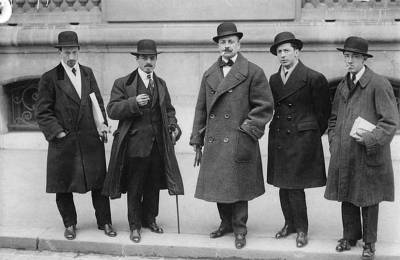
Following the launch of the Futurist movement through the 1909 publication of its manifesto in the French daily newspaper, Figaro, Severini was invited by Filippo Tommaso Marinetti (the first manifesto's author) and Boccioni to join the group. He agreed and was a co-signatory, with Balla, Boccioni, Carlo Carrà, and Luigi Russolo, of two further manifestos: Manifesto of the Futurist Painters (February 1910) and Technical Manifesto of Futurist Painting (April 1910). Of all the modern movements, Futurism was the most fervent in its repudiation of the past. Italian culture was tied more than most other modern European countries to its ancient history and Marinetti declared that the Futurists would "free Italy from her innumerable museums which cover her like countless cemeteries" by celebrating the modern industrial world and the "beauty of speed". In one of his typically provocative statements, he went so far as to suggest that "a racing motor car [was] more beautiful than the [celebrated ancient sculpture] Victory of Samothrace".
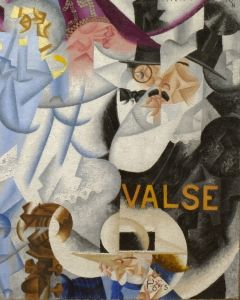
The art historian Charles Harrison observed that "The Futurists were much taken with the ideas of the French philosopher Henri Bergson, who wrote of change as the essence of reality" and that such ideas "were clearly inviting to those, like the Futurists, who were seeking stylistic forms for 'modern' sensations". Like his colleagues in Italy, Severini employed elements of Neo-Impressionism and Cubism to recreate the uniquely modern sensations of dynamism and energy; stating that, "Futurism, as an intellectual practice, created a 'poetics' based on real life, of such a creative potential as to be inexhaustible, and therefore always present to those concerned with art". Yet, as an Italian artist immersed in the culture of the Parisian avant-garde, his painting was not preoccupied with pistons and machines so much as with capturing the frivolities of metropolitan life. He had a particular penchant for painting nightclub scenes - such as the canonical Dynamic Hieroglyphic of the Bal Tabarin (1912) - through which he sought to capture on canvas the human sensations and atmosphere of movement and sound. Following a visit to Paris in 1911, the Italian Futurists absorbed some of Severini's influence by adopting some of the humanist features of Cubism, namely the human figure in motion, as further means of expressing pictorial dynamism.
In February 1912, Severini took part in the first Futurist exhibition outside Italy at Galerie Bernheim-Jeune, Paris. The touring exhibition moved on to London (before Berlin and Brussels) where it was greeted with great public curiosity. Writing for the Burlington Magazine, Barbara Pezzini observed that by the time the exhibition opened at the Sackville Gallery, Marinetti's manifesto had gained widespread notoriety, not least for dismissing the "art of the past [as] 'a funeral urn' from which the artist would emerge 'exhausted, reduced [and] downtrodden'". It was these provocative views that made the London exhibition (featuring 35 paintings by Severini, Boccioni, Carrà and Russolo) "irresistible to press and public alike". But Severini's simmering scepticism about Futurism's credentials to be taken seriously as a radical avant-garde movement - an attitude only reinforced by his friend Apollinaire who, following the Galerie Bernheim-Jeune exhibition, had mocked the Futurists for their "provincialism" and a general ignorance of the rising currents in the French avant-garde (namely Cubism) - was already growing. Pezzini observed, indeed, that in London critics ignored the "verbal explosions of the manifestos" and rather "singled out works that portrayed the non-threatening aspects of modern life, such as Severini's Parisian nightlife scenes".
According to Pezzini, the Sackville Gallery was a "'sacred' space where works of art were meant to transcend their financial value". The Sackville had a "sister" gallery too, the Marlborough Gallery, which Pezzini likened to "a picture gallery in a stately home". It was there that Severini held his first one-man exhibition in April 1913. Pezzini continued that some modern galleries "offered their rooms to whoever paid their rent" but that the Marlborough was very much "a self-aware gallery for connoisseurs [...] that exhibited works by old masters" and that the Severini exhibition was an isolated, but significant, event in its 22 year history. Severini had loosened further his firm ties to the Futurist movement with the Marlborough exhibition, though any rise in his profile hardly eased his financial situation and, for a third time, his studio in Paris was impounded. Nevertheless, Severini, whose exhibited works revealed the various influences of Pointillism, Neo-Impressionism, Van Gogh, Toulouse-Lautrec, Degas and Picasso in lively urban scenes such as The Boulevard (1913), had won over the esteemed British critic Roger Fry while he formed a new friendship with the British painter CR Nevinson. In August that year the 30-year-old Severini married Jeanne, who was just 16, at a ceremony in Paris. "I tried not to show it", he wrote, "but I was deeply moved".
Soon after his marriage, Severini succumbed for a second time to pleurisy and was ordered by medics to take time off to recuperate. The near destitute couple moved to the Italian town of Montepulciano in 1914 to live with his parents and it was while there that Jeanne became pregnant. Severini recalled mournfully "This was not a happy occasion at all. It was a tragic event that complicated everything and created terrible problems for us". Jeanne's pregnancy coincided with the outbreak of the first World War prompting the newlyweds to sell everything they owned and to move back to Paris (Severini would be spared from serving in the war due to his lung condition). The couple's daughter, Gina - "a skinny little creature but with such a vivacious, pretty little face that she immediately captivated us" - was born in January 1915. But the young family were living on just four francs a day and Severini's health continued to deteriorate. His friend Picasso put him in touch with a doctor in Spain and Severini travelled to Barcelona for treatment and then on to the Pyrenees for a period of rest and recuperation. He was shocked on his return to find Jeanne and Gina in a state of near emaciation: "They were both so thin that I barely recognized them" he recalled. In an attempt to improve their situation, the Severini's moved to Igny in the countryside outside Paris where he sought, unsuccessfully, to find paying work. In 1916 the couple had a son, Tonio, who failed the thrive and died of pneumonia; a profound loss that would reverse Severini's atheism.
Severini did allow the war to inform his painting with his war works becoming, in the words of Coen, "more solid and volumetric in treatment". In Red Cross Train Passing Village, for instance, we see a locomotive thundering through the countryside of Igny. The fractured planes, the use of signage and text and the collage-like signal-crossing all owe their debt to Cubism, while the Pointillist rendering of the roofs, trees and hills draw on Seurat's influence. It is the subject matter and the vivid palette that ties the work to the Italian Futurists. Curator Jennifer Blessing stated: "In this painting of a train moving through the countryside, Severini split the landscape in order to impart a sense of the momentary fractured images that characterize our perception of a speeding object. The clash of intense contrasting colors suggests the noise and power of the train, which the Futurists admired as an emblem of vitality and potency".
By 1916 Severini was embracing a more orderly approach to his painting; his goal being to "construct" rather than "deconstruct" the world around him. The curator Andrew Mead argued that "Severini thrived on that change of direction" since, for him, "the 'radical' Futurist works now seem[ed] rather laboured and formulaic", and that, while Futurism might have been for a time "historically significant in attempting to capture what was happening to vision in the modern world [it proved] hardly fluid enough to convey a true sensation of speed". With the new aim of bringing geometric order to his painting, Severini experimented with still-life compositions based on the collage effects of Synthetic Cubism, but with portraits such as Maternity (1916), his work was pointing towards a more conservative "Return to Order" style known otherwise as Interwar Classicism. Indeed, Coen observed that with Maternity, a "dramatic change of style" occurred in Severini's painting that saw him progress from "the decomposition of volumes [...] towards a formal purity inspired by the tradition of the Italian Renaissance".
Meanwhile, Futurism was beginning to gain traction in America where Severini exhibited with the Futurists in San Francisco at the 1915 Panama-Pacific International Exposition. And, in 1917, he was invited to exhibit his Futurist paintings at Alfred Stieglitz's 291 gallery in New York. In 1918 Severini left Paris as the German armies encroached on the capital. He took refuge in Aix-les-Bains, near Chambéry, and then at Le Châtelard in the Savoy where he produced a series of still-lifes and landscapes composed along precise geometric principles. In 1919 (after the war) the Italian signed a three-year contract with the dealer Léonce Rosenberg who was best known for his dealings with the Cubists. Severini's financial situation improved but his change in fortunes was offset by a sense of collective tragedy which started when his dear friend Apollinaire lost his life to the Spanish Flu in 1918. In 1919 Modigliani died of tuberculosis, followed quickly by his grief-stricken (and pregnant) wife Hébuterne who threw herself to her death. Severini wrote: "For a long, long time afterward, all the artists suffered profound sorrow, not visibly, but in the depths of all their hearts".
Later Period
In the early 1920s Severini divided his time between France and Italy. He received a commission to decorate the home of the Sitwell family at Castello di Montegufoni on the outskirts of Florence with his fresco, completed in 1922, featuring characters based on the theatrical tradition of commedia dell'arte. Coen observed that the Castello fresco "was the first of a long series of wall decorations painted under the stimulus of a rediscovered religious faith, strengthened by his friendship with the Catholic philosopher Jacques Maritain". Having gone through something of a spiritual renaissance, Severini abandoned his commitment to Futurism and aligned rather with the "Return to Order" movement; adopting a Neo-Classical approach to painting which extended to detailed studies of Giotto.
In 1921 he published a book, Du cubisme au classicisme (From Cubism to Classicism), in which he presented his theories on mathematical rules of composition and proportion. He began to apply theories of classical balance based on the principles of the Golden Section and he exhibited to acclaim at the Rome Biennale in 1923. From 1924 Severini worked on a cycle of murals for the church of Semsales in the Canton de Fribourg, Switzerland, and, in 1928, he completed frescoes for the Baroque church at La Roche, near Aigle, Switzerland. Coen writes that "In these decorations, still Cubist in spirit, he expressed his search for proportionality between subject and object [...] according to the laws of 'sensibility' and 'intelligence'". By the late twenties Severini began to incorporate elements of Roman landscapes into his repertoire and in 1926 and 1929 (in Milan and Geneva respectively) he exhibited with artists connected with the Novecento Italiano group; a group sympathetic to Fascism who formed with the aim of reviving the tradition of large format history painting and sculpture in the classical tradition.
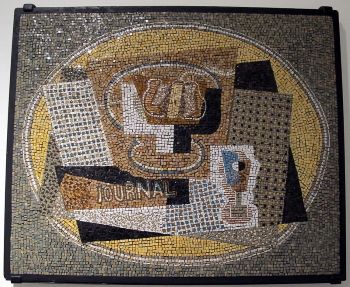
During the late 1920s and early 1930s, Severini's work showed at several important exhibitions including the 1930 Venice Biennale, the Rome Quadrennials of 1931 and 1935 (when he had an entire room devoted to his work and won the first prize for painting) and the Paris exhibition of 1937. He continued to produce religious murals and provided illustrations for books by Paul Fort and Paul Valéry. But it was for his mosaics that he started to gain most notice, earning him the title, in fact, of "father of modern mosaics". In 1933 he was commissioned to produce a mosaic for the reception hall of the new Palazzo della Triennale in Milan and to decorate the church of Notre Dame du Valentin in Lausanne but later in the decade he became directly associated with Benito Mussolini's "Third Rome" project of constructing grandiose architectural monuments inspired by the Roman forums of the imperial age.
Severini produced mosaics for the Palazzo di Giustizia in Milan (1936), the Palazzo delle Poste in Alessandria (1936) and mosaics and frescoes at the University of Padua (1937). As Coen observed, he "was stimulated by the ideal, current in those years, of creating a new relationship between architecture and the visual arts [and in] the late 1930s he also created numerous sets and costumes for the theatre". Perhaps the most important of the Mussolini structures were, however, the Foro Italico, a multi-venue sports complex, built to support a (failed) bid by Rome to host the 1940 Olympics, and Palazzo degli Uffici, the inaugural building of the new district of EUR, which was intended to herald the (cancelled) 1942 World Fair. Though any association with the Fascist pursuit of empire was roundly condemned within the international artistic community, the art historian Kate Flint offered mitigation when making the point that "until the late 1930s abstract art was not regarded by the majority of [Italian] Fascist officials as dissident, 'degenerate', art is in Nazi Germany" and there was thus "little scope for attacking the regime though stylistic avant-garde techniques". Nor was it the case that Severini's mosaics was specifically "pro-Fascist"; rather, "the style of the régime [...] rested on Mussolini's principle of a 'return to order'".

Having published his autobiography, Tutta la vita di un pittore (The Life of a Painter) in 1946, Severini returned to Paris where he worked in what might be described as a Neo-Cubist style that saw him revisit his earlier preoccupations with dancers, light and movement. He also found time to establish the School of Mosaic in Paris in 1950. Back in Rome, he completed what was arguably his most expansive mural for the 1953 International Exhibition of the Federation of Agricultural Enterprises in the grand hall at the Palazzo dei Congressi. In Rome, he also received commissions to decorate the offices of the Italian airline companies KLM and Alitalia (on flights during the 1960s, Alitalia stewards would even display small (in size) works by Severini and Balla for the "aesthetic pleasure" of its passengers). In his birthplace of Cortona, meanwhile, Severini left his lasting signature on its architecture with his Mosaic of San Marco (1961) which adorns the front-facade of the city's Church of St. Mark. Severini died in Paris on February 26, 1966, aged 82 but, according to his wishes, he was buried in Cortona.
The Legacy of Gino Severini
As an artist with one foot in two camps - French modernism and Italian classicism - Severini holds a unique place in twentieth century European art. As White put it, "Severini's most Italian qualities are also his least modernist [and] that he is only French when his work adheres to historiographical perceptions of what modernist painting can be". Though some have found him difficult to place, White's view is that his "dual heritage [...] makes Severini's practice much richer than that of many of his contemporaries". Severini's explorations into Cubism, Futurism, Neo-Impressionism, and later, mosaics, certainly made him one of the most significant Italian figures in modern art and he can take credit for showing the world that contemporary Italian art amounted to more than a fetishistic attachment to machinal structures. The art historian Ilona Jesnick insists that he was not just important to Italian modernism but "pivotal to Modernism" per se. Artists who have listed Severini among their inspirations include the Neo-Impressionists, Christopher Nevinson, Joseph Stella, and Rafael Barradas.
Severini was something of a renaissance man who moved freely from painter, to theoretician, to designer, to teacher, to mosaicist. But it is probably his contribution to the art of mosaics that truly distinguishes him from his peers. He was the driving force of mosaics in Paris (where he established a dedicated school) and, having studied the Early Byzantine mosaics of Ravenna, he likened the laying of tesserae to brushstrokes of Cezanne and the Pointillism of Seurat. It was Severini, the "father of modern mosaics", who elevated the medium to new heights of appreciation as an artform.
Influences and Connections

-
![Georges Braque]() Georges Braque
Georges Braque -
![Pablo Picasso]() Pablo Picasso
Pablo Picasso -
![Umberto Boccioni]() Umberto Boccioni
Umberto Boccioni -
![Suzanne Valadon]() Suzanne Valadon
Suzanne Valadon ![Giacomo Balla]() Giacomo Balla
Giacomo Balla
-
![Joseph Stella]() Joseph Stella
Joseph Stella ![Christopher Nevinson]() Christopher Nevinson
Christopher Nevinson- Rafael Barradas
-
![Fernand Léger]() Fernand Léger
Fernand Léger -
![Georges Braque]() Georges Braque
Georges Braque -
![Pablo Picasso]() Pablo Picasso
Pablo Picasso -
![Umberto Boccioni]() Umberto Boccioni
Umberto Boccioni ![Giacomo Balla]() Giacomo Balla
Giacomo Balla
Useful Resources on Gino Severini
- Futurism (Movements in Modern Art series)By Richard Humphreys
- Gino Severini: From Futurism to ClassicismBy Simonetta Fraquelli and Christopher Green
- Primitivism, Cubism, Abstraction: The Early Twentieth CenturyBy Charles Harrison et al
 Ask The Art Story AI
Ask The Art Story AI